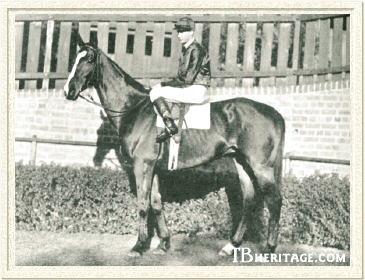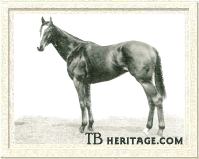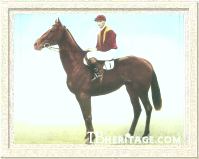|
|
Gloaming

|
|
 |
|
|
The remarkable racing career of Gloaming has frequently been obscured by the successes of Australasia's other beloved heroes, Carbine and Phar Lap. Gloaming came along in the years immediately after the end of World War I, and his consistency and durability made him the hero of two nations, reeling from the loss of a generation of young men. He ran sixty-seven times, and won fifty-seven, placing second nine times, meeting and beating the best in Australia and New Zealand, right up to the triumphant end of his career at age ten.
Gloaming was bred by E.E.D. Clarke and foaled on September 26, 1915 at Clarke's Melton Stud in Victoria, Australia. He was sired by The Welkin, and from the Eager mare, Light. The Welkin had been a modestly talented son of English Triple Crown winner Flying Fox. During four years on the racecourse, The Welkin won six times and was placed second or third seven times in 23 starts; he won the Royal Stakes at Newmarket over ten furlongs, but the rest of his successes, such as Doncaster's Portland Plate and Newmarket's July Handicap, were all sprints. His stud services were not eagerly sought after in Britain, both because of his less than stellar racing career, and his somewhat plebeian female family, none of his first four dams having produced anything of the highest class. Consequently, the young stallion was sold for only 600 guineas, and shipped to Australia to stand at Clarke's Melton Stud. He turned out to be bargain, as The Welkin was leading Australian sire three times and second on the top sires list twice. His other leading performers included Rosehill Guineas winner Furious; Spring Stakes winner Greenstead; Caulfield Guineas winner Thrice; and AJC Epsom Handicap winner Blackadder.
Gloaming's dam, Light, also British-bred, proved useless on the racetrack, failing to win or place in four starts. She had some class in her pedigree, her sire Eager being a winner of the July Cup, Derby Gold Cup, and twice winner of the Rous Memorial Stakes. Her dam, No Trumps, was a daughter of Bend Or's good racing son Orvieto, and she was a half-sister to the good performers Bill of Portland (a successful stallion in Australia) and Dynamo. Bred and by R.H. Combe, she passed through several hands before her sale to J.E. Brewer, who was acting in England as an agent for Clarke. Exported to Australia, all ten foals Light produced were sired by The Welkin. In addition to Gloaming, her daughter Refraction was twice placed in Australian classics, and daughters Lightsome and Gloaming's Sister won stakes.
Gloaming was a plain-headed bay with a blaze and white off hind ankle, a long, ewe neck, and strong hip. He "stood over a lot of ground," and later showed himself to be an outstanding mover, with an enormous stride. His breeder held a sale of yearlings every year, but Gloaming attracted little interest. The colt was recovering from strangles, which further lessened his desirability. When he sold, it was for the paltry sum of 230 guineas, but agent Harry Chisholm, who had been instructed to spend up to 500 guineas for a yearling by The Welkin, liked him and his pedigree, which to Chisholm suggested "tremendous" speed. Gloaming's new owner, New Zealander George D. Greenwood, brought the colt across the Tasman Sea to New Zealand to be trained by Richard "Dick" Mason, who had huge success training for the leading owner in New Zealand of the '80s and '90s, George Stead, and after Stead's death, was the key Greenwood needed before he established his racing stable at Teviotdale station (Canterbury) in 1908.
Gloaming on the Turf
During his training, Gloaming exhibited considerable talent. When he went shin sore at age two, he was gelded and turned out. After returning to serious training, Gloaming displayed such promise, it was decided to let him have his chance at Australia's classic races, and he made the second of fifteen trips across the Tasman Sea to debut at Randwick. Gloaming's first race was the Chelmsford Stakes, and despite a clumsy start, he recovered to win by an authoritative eight lengths, setting an Ausralasian record for nine furlongs. Three weeks later, in only his second start, Gloaming captured the AJC Derby.
|

Gloaming at age 3
| |
Shipped back to New Zealand, Gloaming remained there for the rest of his three-year-old season. In the Champion Plate at Wellington, with only two prior starts, Gloaming manhandled older performers. He then easily took the New Zealand Derby. Gloaming met the first defeat of his career in his next start, the G.G. Stead Memorial Stakes, losing the race by 2-1/2 lengths to very good older horse, Sasanof. Shortly thereafter, Gloaming turned the tables on Saranof by defeating the latter at Ellerslie in the Islington Plate. By capturing the Great Northern Derby in his next start, Gloaming became the first horse in the history of Australasian racing to win the AJC Derby, New Zealand Derby, and Great Northern Derby. Victories followed in the Wellington Stakes at Trentham, and the Kelburne Plate before he suffered a second defeat in the Taranaki Stakes.
|
Overeager at the start, the gelding got tangled in the old-fashioned barrier tapes and immediately lost four lengths. Once free, he ran a remarkable race. Nearing the turn for home, he encountered traffic problems. The nimble gelding found room, but despite his charge, missed victory by only neck, his conqueror being the older champion mare Desert Gold. A week later, Desert Gold suffered the same fate as Gloaming, being caught in the barrier tapes. Once she got running, she was directly in the path of Croesus, who had fallen in the race. The courageous mare jumped over the prostrate horse and kept charging at Gloaming, only to succumb to a 2-2/2 length defeat. In his next start, Gloaming again met Desert Gold, and the two hooked up in the straight, with the mare actually pushing her nose ahead of her younger rival. Gloaming found another reserve and managed to wrestle the lead from Desert Gold and go on to a 1-1/2 length victory.
Three more easy victories came Gloaming's way in the Wanganui Jackson Stakes, Wanganui Guineas, and Challenge Stakes at Canterbury. Gloaming's last race of his first season came in the North Island Challenge Stakes at Trentham. Heavily favored, once again, Gloaming was too eager for the start. He again became caught up in the barrier tapes. This time he fell, and failed to participate further in the race.
Put away for the southern hemisphere winter, Gloaming made his re-appearance as a four-year-old in September, 1919, at the Rosehill course in Australia. There he captured the Spring Stakes. From there it was on to Randwick and an upset by a head to Poitrel in that course's Spring Stakes. He ended his Australian sojourn by taking the Craven Plate. That was all the Australian public saw of him the rest of the season, as Gloaming was shipped back to New Zealand for the rest of his four-year-old campaign.
Back in New Zealand, Gloaming again met up with old rival Desert Gold in the Champion Plate at Trentham. Gloaming won from Affection, with Mascot third. Desert Gold finished a gallant fourth, having had trouble with the barrier tapes at the start. The G.G. Stead Memorial Gold Cup at Canterbury was next on the agenda for both Gloaming and Desert Gold. Gloaming won comfortably from Rossini, with Desert Gold third. The seven-year-old mare was thereupon retired to the breeding ranks. Gloaming had only two more starts at four, the Islington Plate at Ellerslie and the Royal Stakes only three days later. He won both, defeating Rossini in the former and toting 134 pounds to victory in the latter.
It was planned to have Gloaming start his five-year-old season as he had before, returning to competition in Australia. He trained brilliantly upon reaching Australia following his winter hiatus. Then a sudden severe bleeding episode scrapped plans for an Australian campaign and Gloaming went back to New Zealand. Having earlier in his career been a classic distance specialist, Gloaming as a five-year-old only once participated in a race beyond a mile, and that was the 1-1/2 mile Auckland Plate, which he won with ease.
Gloaming started his five-year-old season in the four furlong Electric Plate, beating the brilliantly fast juvenile colt Rational while giving the younger horse nearly thirty pounds. A victory in the five furlong Fielding Stakes followed, then the 5-1/2 furlong Fielding Oroura Stakes. His next victory came in the Islington Plate, his third straight win in this event.
The Auckland Plate was next. Only three weeks after his win in the twelve furlong Auckland Plate, Gloaming dropped to four furlongs for an easy win in the Kleburn Plate. Gloaming participated in six more races that season, and won them all, including the Egmont Stakes and Challenge Stakes at Canterbury. Thus, following his bleeding attack at the beginning of the season, Gloaming enjoyed an undefeated five-year-old campaign, winning all twelve of his engagements. He had won seventeen races in succession, his last defeat coming in the Spring Stakes at Randwick the season previous.
After a winter rest, Gloaming was once again shipped across the Tasman Sea to open his six-year-old campaign in Australia. Once again, Australian race fans were disappointed, as Gloaming became ill shortly after his arrival in Sydney and never made a start in Australia that season. Sent back to New Zealand, Gloaming, once recovered, made eleven starts and emerged victorious ten times. Victories in the Fielding Stakes and the Oroua Stakes gave him nineteen victories in a row, thus tying him with his formidable old rival, the mare Desert Gold.
Gloaming then lined up against only three opponents for his attempt at a fourth win in the Islington Plate. The crowd in attendance was stunned to see Gloaming finish second to the lightly-regarded Thespian, the younger colt throwing a record mile at his older rival in order to defeat him. Thespian was unplaced to Gloaming the next time they met, in the Auckland Plate, second to Gloaming in the Egmont Stakes, and defeated by him again in the Hawera Stakes. On the season, Gloaming added victories in the Taranaki Stakes, Jackson Stakes, North Island Challenge Stakes, the Challenge Stakes at Canterbury, and the J.D. Ormond Memorial Gold Cup.
Gloaming as a seven-year-old succeeded in opening his season in Australia. Another gelding, the year-younger Beauford, had captivated Australian fans with his victories, and the two lined up to square off in the Chelmsford Stakes. The two geldings put on a fierce display, with Beauford getting the victory over Gloaming by a length. They met again a week later, in the Hill Stakes. This time Gloaming got the upper hand and beat Beauford by 1-1/4 lengths. The twelve furlong Spring Stakes was next. Gloaming met with some interference, allowing Beauford to draw off to a seemingly insurmountable lead. Once in the clear, Gloaming made a valiant effort, but at the finish, came up just a neck short.
|

Gloaming
| |
The final meeting of these two formidable old geldings took place in the Craven Plate. Beauford was seemingly running easier of the two, as Gloaming had to work hard to draw even with his rival. Once he did, it was over, as he drew off to win by three convincing lengths. In winning this edition of the Craven Plate, Gloaming not only evened his score with Beauford at two victories apiece in four meetings, but he surpassed Carbine's earnings mark to become Australasia's all-time leading money winner.
Once back in New Zealand, Gloaming was definitely not himself. He made only one start, capturing the Champion Plate at Wellington. The aging horse was clearly tired . It was decided to put him away for a long rest.
|
The spring of 1923 saw Gloaming again in Australia to launch his eight-year-old campaign. But a minor injury prevented him racing there. He returned to New Zealand, was rested for another length of time, and reappeared under colors again in January of 1924, a year and three months after his last race. As an eight-year-old, Gloaming raced five times, and won four. His victories included the Waterloo Stakes, the Middle Park Plate at Canterbury, the Jackson Stakes at Wanganui, and the North Island Challenge Stakes. In his season finale, Gloaming suffered a bad start and lost considerable ground. His furious stretch rally fell a head shy of catching the New Zealand classic-winning three-year-old filly Razzle Dazzle.
Gloaming crossed the Tasman Sea yet again to begin his nine-year-old season in Australia. Despite his advanced age, the old warrior had lost none of his competitive fire. In his first race of the season, the Chelmsford Stakes, Gloaming met the crack three-year-old Heroic. Gloaming ran into traffic trouble, as his much younger rival enjoyed a clear run. Once free of the trouble, Gloaming made a huge run after Heroic, but fell short by just over a length.
Bad racing luck again plagued Gloaming in his next start, the Hill Stakes, as he was again trapped in traffic and his late charge fell a neck short of catching the winner, the gelding Ballymena. The latter was a brave performer, and he and Gloaming met again in the Spring Stakes, with Gloaming capturing first prize and Ballymena running third. Only four days later, these two geldings met in the Craven Plate. They locked horns for a good portion of the race, it looking for all who were there to witness that they might finish in a dead heat. Only an extra lunge at the end propelled Gloaming to victory by a head. In a tragic anticlimax to this wonderful race, Ballymena met with a fatal injury in training shortly after his gallant effort against Gloaming in the Craven.
For his final racing appearances in Australia, Gloaming was sent to Victoria, where he easily captured the Melbourne Stakes. During his stay in Victoria, owner Greenwood sent Gloaming for an exhibition gallop on Cox Plate day and had him paraded before the huge crowd for the Melbourne Cup.
Once back in New Zealand, Gloaming competed for and won prizes he had notched several times before, namely the Middle Park Plate at Canterbury and the North Island Challenge Stakes. Then an easy win in the six furlong Hawke's Bay Stakes set him up perfectly for a confrontation with The Hawk, a rising star in Australia by virtue of seven straight victories.
The British Bloostock Review of 1925 described the struggle between these two outstanding competitors. "The two horses got away on equal terms. Both by the way carried nine stone ten pounds (136 pounds) over the mile. At the end of three furlongs, The Hawk was leading by two lengths. A furlong further on, Gloaming had drawn level, and shortly thereafter, got his head in front. Whilst traversing the sixth furlong, The Hawk was once more in front, but only slightly. He was now under the whip, whereas Gloaming was being merely hand-ridden. In the final furlong, Gloaming definitely got the upper hand, and gradually drawing away, won readily by a length. The enthusiasm of the great crowd that had assembled to witness the contest was tremendous. The result was in accordance with the desire of the vast majority, but the gallant effort The Hawk had made against his big far-striding conqueror was heartily recognized and so he too, received an ovation."
This was Gloaming's final race. During his glorious career, he had won 57 of his 67 starts, and placed second nine times. His only time out of the top two was the race in which he fell at the start. He captured the Islington Plate three times, the Egmont Stakes three times, the Wanganui Jackson Stakes four times, the North Island Challenge Stakes three times, and the Challenge Stakes at Canterbury four times. During one stretch encompassing the seasons of 1919/1920 through 1921/1922, Gloaming won an incredible 28 of 29 starts.
Gloaming was an exceptionally intelligent horse with a gentle disposition. He was a bit of a gourmand, tending to want to eat everything in sight to such extent he had to be muzzled to keep him from devouring his straw bedding. He was exceptionally fond of apples. Upon finding that he was rewarded with one after a victory, he soon came to ask his human caretakers for one by way of a nudge or nicker after a victory. He was well aware of his losses, for he never begged for his favorite treat when he lost. Only one time other than a victory did the grand old horse beg for an apple, and that was following his disastrous fall in the 1919 North Island Challenge Stakes. His humans gladly gave him one.
Gloaming died at the age of seventeen, in May of 1932, only a month after the mysterious death of Australasia's newest racing icon Phar Lap. Following his racing career, Gloaming lived a leisurely life as a pensioner at owner Greenwood's farm near Teviotdale, North Canterbury. When he died, Gloaming was buried there, his grave site becoming known as "Gloaming's Hill." Both his owner G.D. Greenwood and his trainer Dick Mason died the same year.
--by Liz Martiniak
|
|
|
|

